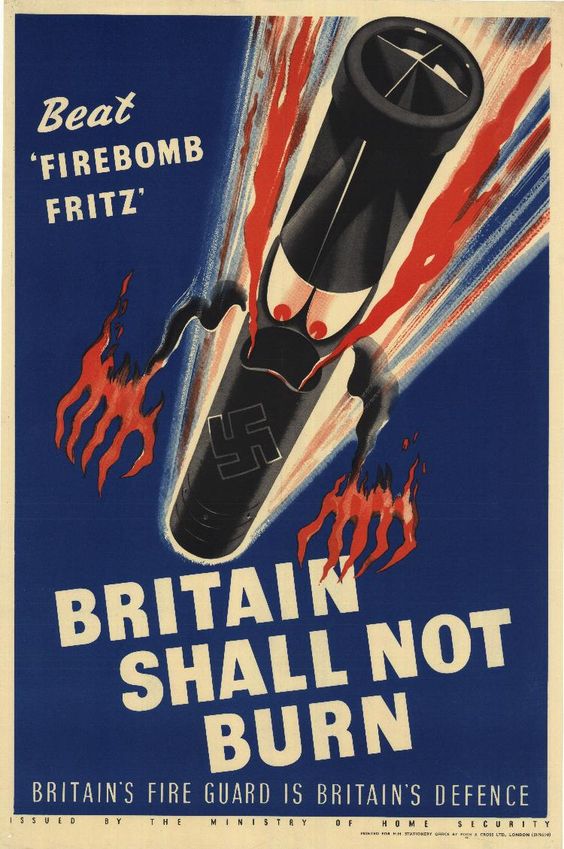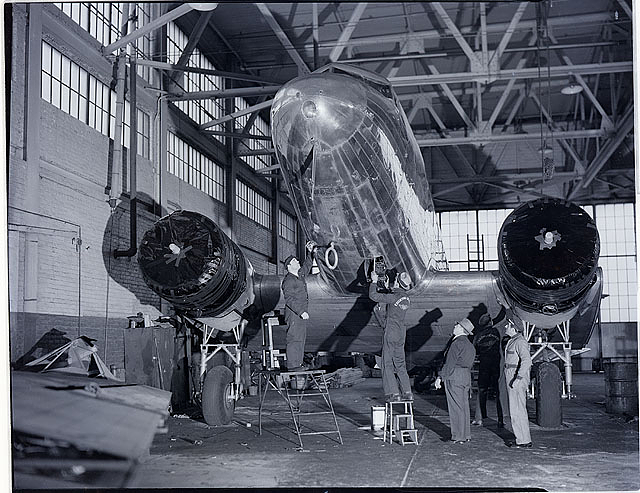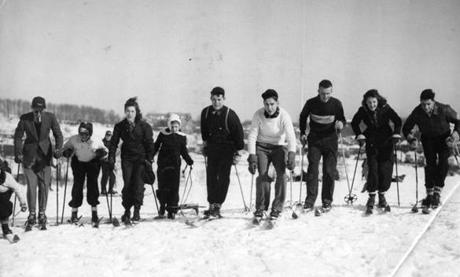Sunday 29 December 1940
RAF Bomber Command raids the port of Valona in Albania.
Mussolini sacks Ubaldo Soddu, the Italian commander in Albania, after only four weeks. Ugo Cavallero takes over for Soddu, combining his position as Chief of the General Staff (which he has held for only three weeks) with overall command in Albania. After reviewing the situation, Cavallero concludes that the "period of crisis [was] almost overcome."
 |
| "Windscreen, steering wheel and bell of fire engine silhouetted against burning building in south (?) London.." 29 December 1940. © IWM (IWM FLM 2319) |
The incendiaries create a firestorm in the City of London, with over 1500 fires combing in three major centers that themselves later combine. Incendiaries individually are not terribly difficult to deal with, but typically multiple incendiaries fall on roofs near each other, and the small fires they create individually combine to create larger fires.
The headline for the attack is that eight historic Christopher Wren churches are destroyed - which certainly is terrible - but the damage goes far beyond that. It includes the utter destruction of the 500-year-old Guildhall, Paternoster Row with an estimated 5 million books, and about a dozen churches in addition to the Wren ones. This becomes known as the "Second Great Fire of London," the first being in 1666. Fortunately, for the damage caused, casualties are relatively light, with over 160 civilian deaths, 14 deaths of firemen, and 250 firemen injured.
The number of incendiaries dropped is larger than usual, and the British government quickly takes steps to try and minimize their effectiveness. Incendiaries create powerful effects only if left to work unhindered, so the government mandates fire-watching and makes workers responsible for dousing them at their places of business. Clergymen and 200 volunteer firewatchers ("St. Paul's Watch," recruited from the Royal Institute of British Architects) at St. Paul reportedly saves the church by actively patrolling the roof and putting out incendiaries before they can set uncontrollable fires - exactly what the government wants everyone to be doing.
The attack is considered to be the most destructive of the entire war in Britain, with the devastation from Islington to St. Paul's Churchyard. This attack leaves a lasting impression. Arthur "Bomber" Harris, Deputy Chief of the Air Staff, watches the bombing from the roof of the Air Ministry. He comments: "Well, they have sown the wind."
RAF Bomber Command, meanwhile, raids Frankfurt, Boulogne, and Hamm.
 |
| After the raid on 29 December 1940, the government ramps up its campaign to guard against fires started by incendiary bombs. |
German 997-ton freighter Adriana hits a mine and sinks off the Elbe River.
German 5642-ton freighter PLM-23 runs aground in a storm off Scharhörn in the Wadden Sea and is written off. This formerly was a French ship which the Germans seized on 5 August 1940.
The Luftwaffe bombs and sinks 41-ton British tug Monarch off Radcliffe Cross Buoy.
The Luftwaffe finds a straggler from Convoy SLS 58, the 5270 freighter Trevarrack, and bombs and damages it.
British 5218-ton freighter Catrine hits a mine and is damaged in Liverpool Bay.
Part of Convoy WS 5A, which had been attacked by German cruiser Admiral Hipper on 25 December, makes port at Gibraltar. The remainder continues on to the south in the Atlantic.
Convoy FN 37 departs from Southend, Convoys FS 374 and FS 375 depart from Methil, Convoy OG 48 departs from multiple ports including Liverpool, Oban, Glasgow and Bristol, Convoy HG 49 departs from Gibraltar, Convoy BN 11B departs from Aden.
Royal Navy destroyer HMS Cottesmore is commissioned and assigned to the 21st Destroyer Flotilla, and HMS Derwent laid down.
Soviet submarine K-56 is launched.
 |
| "Fireman carries rolled hose to hose dump after a night's work, passing bricks and other rubble." This was shot following the raid of 29 December 1940. © IWM (IWM FLM 2318). |
Pursuant to the decisions made at the Cairo conference on 28 December, the Australian 6th Infantry Division practices its assault scheduled for the morning of 2 January 1941 using an elaborate mockup of the Italian perimeter.
The RAF raids Bardia and Italian airfields at Tobruk, Derna, and Benina.
Australian destroyer HMAS Voyager intercepts 190-ton Italian ketch Zingarella on its way from Bardia to Tobruk. The Zingarella is transporting British POWs who now are freed.
US Government: The administration, according to an AP dispatch, is drafting a $17 billion budget for fiscal 1942 (begins in September 1941). This includes $10 billion for armaments.
Secretary of War Henry Stimson tells President Roosevelt (according to his diary entry of this date):
You cannot build a civilization based upon the questions of religion, which is what our civilization has been based on, and not recognize questions of right and wrong in the dealings between nations.Ireland: The Irish Air Force has a rare mission when it attempts, and fails, to intercept a Luftwaffe Junkers Ju 88 which flies over Waterford to Dublin. The plane escapes undamaged.
Vichy France: The Petain government creates a commission for Jewish affairs.
 |
| This photo gives a better idea of the damage from the 29 December 1940 raid than most others. "Scene of desolation viewed from St Paul's Cathedral: photograph was taken after the raid of 29 December 1940 from the Golden Gallery surmounting the Dome of the Cathedral, and showing the devastated area of burnt and broken buildings. It is mainly the famous booksellers' quarter bounded by Ave Maria Lane and Paternoster Row. The domed building is that of the Central Criminal Court (Old Bailey), the four-spired church is St Bartholomew's." © IWM (HU 64317). |
Calling the current European war a "world crisis," Roosevelt calls the Axis "evil forces" and creates one of the great catchphrases of the 20th Century:
We must be the great arsenal of democracy.He concludes that "I believe that the Axis powers are not going to win this war," and sets forth the agenda:
I have the profound conviction that the American people are now determined to put forth a mightier effort than they have ever yet made to increase our production of all the implements of defense, to meet the threat to our democratic faith. As President of the United States, I call for that national effort.Reading or listening to the speech out of context, one could easily assume that the United States is at war and fighting for its life. Instead, the reality is much different: there is a war, but the United States is not part of it, and there is no sign that it ever need be a part of it. However, the thrust of the "Arsenal of Democracy" is clear: the Axis must be defeated, and the United States is going to make that happen. The strategy appears to be, at least for the moment, to build the weapons but let the British and Britain's fighting allies take the casualties. This speech is generally viewed as introducing the concept of "Lend-Lease" to the American people, though Roosevelt had used that phrase previously and does not use those words in this address.
Below is a little "behind the scenes" clip which shows how these speeches are created for inclusion in the newsreels: in individual segments. This is much different than the way Winston Churchill, for instance, gives his speeches, in one extended reading; or how Adolf Hitler gives his speeches, standing at a podium and giving a dramatic oration.
December 1940
December 1, 1940: Wiking Division Forms
December 2, 1940: Convoy HX 90 Destruction
December 3, 1940: Greeks Advancing
December 4, 1940: Italian Command Shakeup
December 5, 1940: Thor Strikes Hard
December 6, 1940: Hitler's Cousin Gassed
December 7, 1940: Storms At Sea
December 8, 1940: Freighter Idarwald Seized
December 9, 1940: Operation Compass Begins
December 10, 1940: Operation Attila Planned
December 11, 1940: Rhein Wrecked
December 12, 1940: Operation Fritz
December 13, 1940: Operation Marita Planned
December 14, 1940: Plutonium Discovered
December 15, 1940: Napoleon II Returns
December 16, 1940: Operation Abigail Rachel
December 17, 1940: Garden Hoses and War
December 18, 1940: Barbarossa Directive
December 19, 1940: Risto Ryti Takes Over
December 20, 1940: Liverpool Blitz, Captain America
December 21, 1940: Moral Aggression
December 22, 1940: Manchester Blitz
December 23, 1940: Hitler at Cap Gris Nez
December 24, 1940: Hitler at Abbeville
December 25, 1940: Hipper's Great Escape
December 26, 1940: Scheer's Happy Rendezvous
December 27, 1940: Komet Shells Nauru
December 28, 1940: Sorge Spills
December 29, 1940: Arsenal of Democracy
December 30, 1940: London Devastated
December 31 1940: Roosevelt's Decent Proposal
2020






